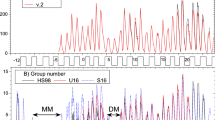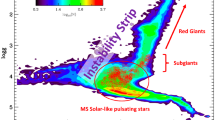Abstract
The origin of Phoebe, which is the outermost large satellite of Saturn, is of particular interest because its inclined, retrograde orbit suggests that it was gravitationally captured by Saturn, having accreted outside the region of the solar nebula in which Saturn formed1. By contrast, Saturn's regular satellites (with prograde, low-inclination, circular orbits) probably accreted within the sub-nebula in which Saturn itself formed2. Here we report imaging spectroscopy of Phoebe resulting from the Cassini–Huygens spacecraft encounter on 11 June 2004. We mapped ferrous-iron-bearing minerals, bound water, trapped CO2, probable phyllosilicates, organics, nitriles and cyanide compounds. Detection of these compounds on Phoebe makes it one of the most compositionally diverse objects yet observed in our Solar System. It is likely that Phoebe's surface contains primitive materials from the outer Solar System, indicating a surface of cometary origin.


Similar content being viewed by others
References
Pollack, J. B. et al. Gas drag in primordial circumplanetary envelopes: A mechanism for satellite capture. Icarus 37, 587–611 (1979)
Burns, J. A. in Satellites (eds Burns, J. A. & Matthews, M. S.) 117–158 (Univ. Arizona Press, Tucson, 1986)
Brown, R. H. et al. The Cassini Huygens Mission. Space Sci. Rev. (in the press)
Owen, T. C. et al. Detection of water ice on Saturn's satellite Phoebe. Icarus 139, 379–382 (1999)
Liou, J. C. & Malhotra, R. Depletion of the outer asteroid belt. Science 275, 375–377 (1997)
Levison, H. F. & Morbidelli, A. The formation of the Kuiper belt by the outward transport of bodies during Neptune's migration. Nature 426, 419–421 (2003)
Brown, R. H., Cruikshank, D. P. & Pendleton, Y. J. Water ice on Kuiper Belt object 1996 TO66 . Astrophys. J. Lett. 519, 101–104 (1999)
Barucci, M. A. et al. Analysis of Trans-Neptunian and Centaur colours: continuous trend or grouping? Astron. Astrophys. 371, 1150–1154 (2001)
Buratti, B. J., Hicks, M. D., Tryka, K. A., Sittig, M. S. & Newburn, R. L. High-resolution 0.33–0.92 µm spectra of Iapetus, Hyperion, Phoebe, Rhea, Dione, and D-type asteroids: How are they related? Icarus 155, 375–381 (2002)
Jarvis, K. S., Vilas, F., Larson, S. M. & Gaffey, M. J. Are Hyperion and Phoebe linked to Iapetus? Icarus 146, 125–132 (2000)
McCord, T. B. et al. Non-water-ice constituents in the surface material of the icy Galilean satellites from Galileo Near-Infrared Mapping Spectrometer investigation. J. Geophys. Res. 103, 8603–8626 (1998)
Clark, R. N. et al. The U.S. Geological Survey, Digital Spectral Library splib05 (Open File Report 03-395, USGS, Denver, 2003); 〈http://speclab.cr.usgs.gov/spectral-lib.html〉
Hook, S. ASTER Spectral Library (Jet Propulsion Laboratory, Pasadena, 2004); 〈http://speclib.jpl.nasa.gov〉
Buratti, B. J. et al. Iapetus: First data from the Cassini Visual Infrared Mapping Spectrometer. Bull. Am. Astron. Soc. 36, 1072 (2004)
Soderblom, L. A. et al. Observations of comet 19P/Borrelly by the Miniature Integrated Camera and Spectrometer aboard Deep Space 1. Science 296, 1087–1091 (2002)
Stein, S. E. NIST Standard Reference Database 35. NIST Spectral Library (National Institute of Standards and Technology, Gaithersburg, Maryland, 2004); 〈http://www.nist.gov/srd/nist35.htm〉.
Gaffey, M. J. Forging an asteroid-meteorite link. Science 260, 167–168 (1993)
Cruikshank, D. P. et al. Search for 3.4-µm C-H spectral bands on low albedo asteroids. Icarus 156, 434–441 (2002)
Brown, R. H. et al. Cassini's Visual and Infrared Mapping Spectrometer (VIMS): Observations during approach and orbit insertion. Astrophys. J. Lett. (in the press)
Cruikshank, D. P. et al. Constraints on the composition of Trojan asteroid 624 Hektor. Icarus 153, 348–360 (2001)
Clark, R. N. et al. Imaging spectroscopy: Earth and planetary remote sensing with the USGS Tetracorder and expert systems. J. Geophys. Res. 108, 5131, doi:10.1029/2002JE001847 (2003)
Acknowledgements
This work was funded by the Cassini project. Authors from American institutions were funded by NASA; authors from European institutions were funded by ESA.
Author information
Authors and Affiliations
Corresponding author
Ethics declarations
Competing interests
The authors declare that they have no competing financial interests.
Rights and permissions
About this article
Cite this article
Clark, R., Brown, R., Jaumann, R. et al. Compositional maps of Saturn's moon Phoebe from imaging spectroscopy. Nature 435, 66–69 (2005). https://doi.org/10.1038/nature03558
Received:
Accepted:
Issue Date:
DOI: https://doi.org/10.1038/nature03558
- Springer Nature Limited
This article is cited by
-
Surface Compositions of Trojan Asteroids
Space Science Reviews (2024)
-
Water and Volatiles in the Outer Solar System
Space Science Reviews (2017)
-
The Moon
Acta Geochimica (2016)
-
Constraints from Comets on the Formation and Volatile Acquisition of the Planets and Satellites
Space Science Reviews (2015)
-
Characteristics of Icy Surfaces
Space Science Reviews (2010)





